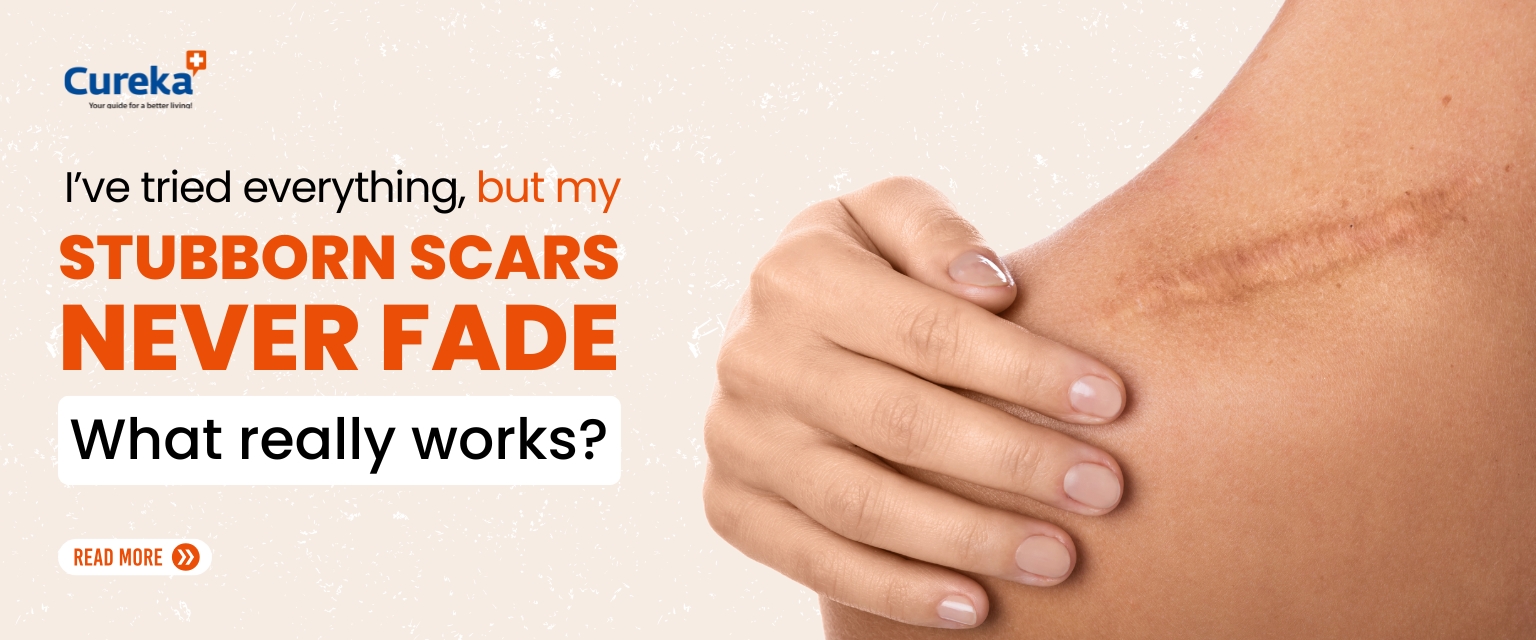I’ve Tried Everything, But My Stubborn Scars Never Fade. What Really Works?
We all have scars; a little reminders of life’s happy and scary journey. But some scars? They refuse to fade. These stubborn scars stick around no matter what we try, be it DIY remedies, over-the-counter creams, or pricey dermat visits. From childhood scars to post-surgery marks, stretch marks, and pitted acne scars, each one tells a story. The real question is: what actually works when nothing else seems to?
Let’s unpack the most effective methods to remove stubborn scars, explore proven scar removal and scar treatment techniques, and decode ingredients that truly make a difference.
Why Do Some Scars Become So Stubborn?
When the epidermis and dermis are disrupted, wound healing takes place. Restoring the integrity and function of the skin is the aim of this complex and well-planned reaction. However, abnormal scarring, such as hypertrophic scarring or keloid lesions, is a result of skin wound healing in hundreds of millions of people.
So in simple term, scars form when the skin repairs itself after injury. While many fade with time, some remain due to deeper skin damage, improper healing, or skin type. Here are common types of stubborn scars:
- Childhood scars from falls or accidents that were never treated properly.
- Stitches scars from cuts or injuries requiring sutures.
- Keloid scars, which grow beyond the original injury site due to excessive collagen buildup.
- Surgical scars that are deep and raised or discolored.
- Stretch marks from weight fluctuations or pregnancy.
- Acne scars, especially pitted scars or boxcar scars, that leave uneven skin texture.
Each type needs a different scar treatment approach, but some options are universally effective.
Why Do Scars Form Differently for Everyone?
Have you ever wondered why some people grow large, raised scars from something as minor as a pimple or bug bite, while others hardly show a mark after a serious injury? Our skin’s ability to recover is influenced by a variety of internal and environmental variables.
1.Your Genes Play a Big Role
If keloids or thick scars run in your family, there’s a good chance you’re genetically predisposed to them. Certain gene mutations—like those affecting TGF-β1 or TNFα pathways—can make your fibroblasts (the cells responsible for producing collagen) go into overdrive. That means more collagen than necessary, leading to raised, firm scars instead of flat, barely-there ones.
2.Age Matters More Than You Think
Babies in the womb can heal without a trace of scarring, thanks to the special type of fibroblasts and collagen they produce. But as we grow older, those scar-free healing abilities fade. Adult skin tends to heal by quickly closing the wound and laying down collagen type I, which is thicker and more rigid—perfect for strength, not so much for smoothness. Fetal skin, on the other hand, is rich in collagen type III and high-molecular-weight hyaluronic acid, both of which help with soft, scarless regeneration.
3.Hormones Can Influence Healing
Women—especially during pregnancy—are more likely to develop hypertrophic scars and keloids. While the exact science is still being unraveled, estrogen is believed to impact fibroblast behavior and collagen synthesis. This may explain the higher scar rates in females, particularly during hormonally active stages of life.
4.Where You Get Injured Also Matters
Some areas of the body are just more prone to scarring—like the chest, shoulders, and upper back. These regions are under constant tension and movement, which can disrupt healing and promote abnormal scar tissue formation. Plus, if the injury goes deep enough to damage glands, hair follicles, or the basement membrane, your risk of visible scarring shoots up.
So… Can We Hack This Healing Process?
Scientists are now exploring ways to “reprogram” adult skin to heal more like fetal skin—less inflammation, better collagen balance, and reduced fibrosis. Ingredients like hyaluronic acid (especially in its high molecular weight form), TGF-β3 boosters, and CD26 inhibitors are being studied for their scar-reducing potential. The future of scar care might lie in gene modulation, peptide therapy, or even stem cell treatments—but for now, choosing targeted, evidence-based products remains your best bet.
Most effective methods to remove stubborn scars:
1.Silicone Gel and Silicone Gel Sheets
If you’re wondering what dermatologists swear by, the answer is silicone. Silicone gel and silicone gel sheets are clinically proven to flatten and soften scars.
- They create a protective barrier, preventing moisture loss and reducing collagen production in raised scars.
- Work well for keloids, surgical scars, stitches scars, and even stretch marks.
- Best results are seen with consistent use over 8–12 weeks.
Silicone remains a gold standard in scar removal, and many consider it one of the most effective methods to remove stubborn scars.
2.Key Ingredients That Help Fade Scars
While shopping for scar creams or gels, look for these potent ingredients:
Heparin
- An anti-inflammatory that also softens fibrous tissue in raised scars.
- Excellent for keloid and post-surgical scar treatment.
Allium Cepa (Onion Extract)
- Found in many OTC scar gels.
- Helps reduce discoloration and scar thickness.
- Mild but effective for stitches scars, childhood scars, and minor acne scars.
Niacinamide and Retinoids
- These powerhouse ingredients work best for acne scars and pitted scars.
- Niacinamide improves skin barrier and tone, while retinoids speed up cell turnover.
- Look for gels or serums specifically for acne scar removal.
These ingredients may not work overnight, but over weeks or months, they noticeably reduce scar visibility—especially when used with other scar revision techniques.
3.Scar Revision Techniques That Actually Work
When topical treatments plateau, it’s time to consider procedural options. Dermatologists use several scar revision techniques tailored to different scar types:
Microneedling
- Stimulates collagen production to smooth out pitted scars and stretch marks.
- Works best when combined with growth factors or PRP (platelet-rich plasma).
Laser Therapy
- Ideal for discoloration, raised scars, and surgical scar treatment.
- Fractional CO2 lasers are often used for acne scars and keloids.
Steroid Injections
- Flatten and fade keloids and hypertrophic scars.
- Often paired with silicone sheets for enhanced results.
Chemical Peels
- Used to treat acne scars and post-inflammatory pigmentation.
- Salicylic acid, glycolic acid, and TCA are common peeling agents.
Each of these scar revision techniques requires professional guidance but can significantly improve even the most stubborn scars.
4.When You’re Dealing with Acne Scars…
- Acne scars—especially pitted scars—are notoriously hard to treat. Here’s a simple breakdown:
- Boxcar and ice pick scars: Respond better to microneedling or punch excision.
- Rolling scars: Improve with subcision and dermal fillers.
- Hyperpigmented acne scars: Fade well with brightening serums and chemical exfoliants.
Topical scar treatments for acne should include:
- Salicylic acid
- Retinol
- Niacinamide
- Vitamin C
- Azelaic acid
Consistency is key here. Results can take months, but these are still among the most effective methods to remove stubborn scars caused by acne.
5.Don’t Underestimate the Power of Massage
Daily massage—especially when combined with a nourishing scar cream—can significantly improve scar texture and flexibility over time.
- Why it works: Gentle pressure stimulates blood flow, encourages lymphatic drainage, and helps break down dense scar tissue.
- How to do it: Use two fingers to apply circular pressure along the length of the scar for 5–10 minutes daily. Always massage in the direction of the scar line to avoid additional trauma.
- Best paired with: Silicone-based gels, onion extract creams, or oils infused with vitamin E or rosehip oil.
Massage won’t erase a scar overnight, but when done consistently, it can enhance the effects of your topical treatments and help soften raised or tight scar tissue.
6.Prevention Is Always Easier Than Cure
We often treat scars too late. Whether it’s a fresh cut, surgery, or breakout, early intervention matters. Here’s how to prevent a scar from becoming stubborn:
- Keep the wound clean and moist (petroleum jelly works wonders).
- Avoid picking or scratching scabs.
- Use silicone gel or scar creams as soon as the skin heals.
- Always wear SPF. Sun exposure darkens scars, making them harder to fade.
These small steps often mean the difference between a faint mark and a lifelong stubborn scar.
So… What Really Works?
A mystical potion that quickly removes scars does not exist. Over time, however, your skin can be transformed by combining the best scar therapy for your scar type, being consistent, and employing tried-and-true components like silicone gel, heparin, and allium. Additionally, treatments like laser therapy and microneedling are used when topicals are insufficient.
The plain truth is that scars that are difficult to remove can be removed with time, the correct technique, and a little perseverance.
Therefore, it might not have been the best option for your scar type if you’ve tried everything and nothing has worked. It’s time to establish a regimen that will eventually cause stubborn scars to fade—for good—now that you know the best ways to get rid of them. Shop them all now in Cureka.
Reference
- Scar Revision- June 20, 2023 – https://www.ncbi.nlm.nih.gov/books/NBK542318/
- Scarring Skin: Mechanisms and Therapies – Jan 2024 – https://pmc.ncbi.nlm.nih.gov/articles/PMC10855152/
- Scar management: prevention and treatment strategies – 2025 Aug – https://pubmed.ncbi.nlm.nih.gov/16012249/











